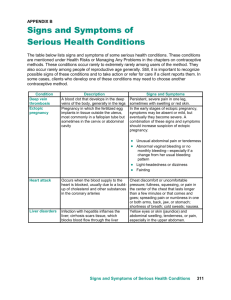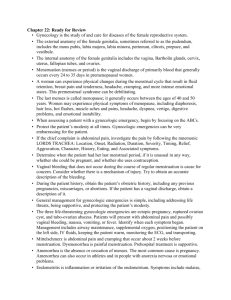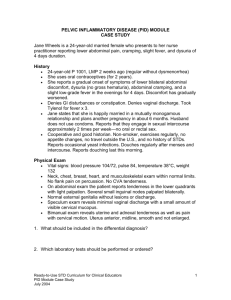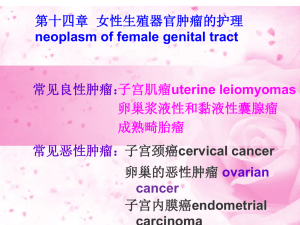Chapter 22
advertisement
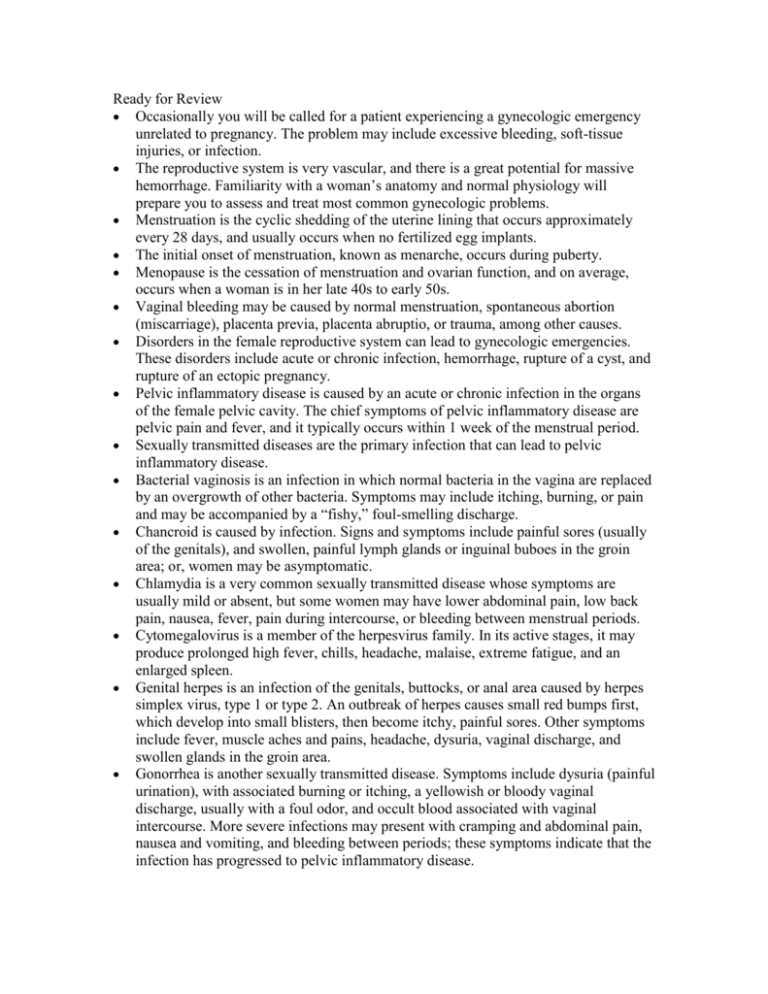
Ready for Review Occasionally you will be called for a patient experiencing a gynecologic emergency unrelated to pregnancy. The problem may include excessive bleeding, soft-tissue injuries, or infection. The reproductive system is very vascular, and there is a great potential for massive hemorrhage. Familiarity with a woman’s anatomy and normal physiology will prepare you to assess and treat most common gynecologic problems. Menstruation is the cyclic shedding of the uterine lining that occurs approximately every 28 days, and usually occurs when no fertilized egg implants. The initial onset of menstruation, known as menarche, occurs during puberty. Menopause is the cessation of menstruation and ovarian function, and on average, occurs when a woman is in her late 40s to early 50s. Vaginal bleeding may be caused by normal menstruation, spontaneous abortion (miscarriage), placenta previa, placenta abruptio, or trauma, among other causes. Disorders in the female reproductive system can lead to gynecologic emergencies. These disorders include acute or chronic infection, hemorrhage, rupture of a cyst, and rupture of an ectopic pregnancy. Pelvic inflammatory disease is caused by an acute or chronic infection in the organs of the female pelvic cavity. The chief symptoms of pelvic inflammatory disease are pelvic pain and fever, and it typically occurs within 1 week of the menstrual period. Sexually transmitted diseases are the primary infection that can lead to pelvic inflammatory disease. Bacterial vaginosis is an infection in which normal bacteria in the vagina are replaced by an overgrowth of other bacteria. Symptoms may include itching, burning, or pain and may be accompanied by a “fishy,” foul-smelling discharge. Chancroid is caused by infection. Signs and symptoms include painful sores (usually of the genitals), and swollen, painful lymph glands or inguinal buboes in the groin area; or, women may be asymptomatic. Chlamydia is a very common sexually transmitted disease whose symptoms are usually mild or absent, but some women may have lower abdominal pain, low back pain, nausea, fever, pain during intercourse, or bleeding between menstrual periods. Cytomegalovirus is a member of the herpesvirus family. In its active stages, it may produce prolonged high fever, chills, headache, malaise, extreme fatigue, and an enlarged spleen. Genital herpes is an infection of the genitals, buttocks, or anal area caused by herpes simplex virus, type 1 or type 2. An outbreak of herpes causes small red bumps first, which develop into small blisters, then become itchy, painful sores. Other symptoms include fever, muscle aches and pains, headache, dysuria, vaginal discharge, and swollen glands in the groin area. Gonorrhea is another sexually transmitted disease. Symptoms include dysuria (painful urination), with associated burning or itching, a yellowish or bloody vaginal discharge, usually with a foul odor, and occult blood associated with vaginal intercourse. More severe infections may present with cramping and abdominal pain, nausea and vomiting, and bleeding between periods; these symptoms indicate that the infection has progressed to pelvic inflammatory disease. Genital warts are caused by the human papillomavirus. Some infected people have no symptoms. In others, multiple growths develop in the genital areas. Syphilis causes signs and symptoms that mimic other diseases. A person with syphilis may remain asymptomatic for years, or have symptoms such as sores, rash, mucous membrane lesions, fever, swollen lymph glands, sore throat, patchy hair loss, headaches, weight loss, muscle aches, and fatigue. Trichomoniasis is caused by a single-celled protozoan parasite. The infected person may be asymptomatic or may experience signs and symptoms including a frothy, yellow-green vaginal discharge with a strong odor, and also irritation and itching of the female genital area, discomfort during intercourse, dysuria, and lower abdominal pain. Symptoms of a vaginal yeast infection include itching, burning, soreness in the vagina and around the vulva, and vulvar swelling. Some women may report a thick, white vaginal discharge (“cottage cheese” appearance), pain during sexual intercourse, and burning on urination. A ruptured ovarian cyst can cause gynecologic/abdominal pain. An ovarian cyst is a fluid-filled sac attached to the inside or outside of the ovary. Such cysts may need to be removed surgically to relieve pressure or to treat infection. Ectopic pregnancy is a pregnancy that develops outside the uterus, most often in a fallopian tube. Symptoms include vaginal bleeding. Consider the possibility of an ectopic pregnancy in any female of reproductive age who has abdominal pain. Most patients experiencing a gynecologic emergency will be treated in the same manner regardless of the cause. Bleeding should be controlled, and the patient’s ABCs should be monitored closely. Watch for developing signs of shock, and treat appropriately. Provide transport to the closest appropriate facility. Patient history has a major role when you are caring for a patient with a gynecologic emergency. Along with a detailed history of the present illness, ask the patient about any previous gynecologic problems and her obstetric history. Consider the possibility of ectopic pregnancy in any patient of childbearing age with abdominal pain. Always question the patient in privacy to maintain confidentiality. Perform a detailed physical examination, with close attention to preserving the patient’s privacy. Expose only the areas that you need to examine, and cover the patient with a sheet. Monitor the patient closely for changes that may indicate that shock is developing. Excessive bleeding is a serious emergency. Cover the vagina with a sterile pad; change the pad as often as necessary, and take all used pads to the hospital for examination. Pharmacologic interventions are generally not indicated. Contact medical control for further instructions. Use local pressure and a diaper-type bandage to hold dressings in place when treating nonobstetric injuries to the external genitalia. Never place dressings in the vagina. Treat patients with these injuries as you would any other victim of blood loss. When the patient is potentially in shock, place her in the shock position dictated by local protocol and keep her warm. Patients with pelvic inflammatory disease generally walk doubled-over, guard the abdomen, and appear ill. Care includes a position of comfort and transport to an appropriate facility. Patients with a ruptured ovarian cyst usually have unilateral pain that may radiate from the abdomen to the back. Rupture of the cyst may result in some vaginal bleeding. Patients with a potential ectopic pregnancy usually present with signs of hypovolemic shock. Monitor the patient and establish a second IV line with a large-bore catheter. Place the patient in the shock position dictated by local protocol. Transport the patient rapidly to the closest appropriate facility. Treat patients with heavy vaginal bleeding on the basis of presenting signs and symptoms. Patients who have experienced abdominal trauma generally present with a variety of signs and symptoms that can include severe bleeding, pain, and hypovolemic shock. Management should be based on patient presentation. In the case of sexual assault or rape, treat for shock if necessary, and record all the facts in detail. Follow any crime scene policy established by your system to protect the scene and any potential evidence. Discourage the patient from washing, douching, or voiding until a physician has examined him or her.

